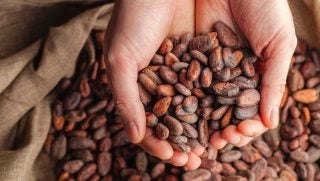Recently, Virginia Tech used its speaker series, known as Tech on Tap, to delve into a pertinent topic that is affecting lives across the country right now: the novel coronavirus. Titled, “The Ripple Effect: Food in the time of COVID-19,” the presentation looked at various ways the food sector has been impacted since the coronavirus spread really took off in the U.S. in early spring.
Robert Williams, professor and Extension food microbiologist, highlighted the consumer response to COVID-19; Joell Eifert, director of the Food Innovations Program, featured the food industry’s challenges and reaction; and Melissa Chase, consumer food safety program manager, discussed food preservation techniques and resources. The wide-ranging discussion was moderated by Renee Boyer, professor and Extension specialist.
Williams, who is with Tech’s Department of Food Science & Technology, spoke first about consumer perceptions amid the pandemic and how there is a greater consumer emphasis on understanding from where food is being sourced and how it is being prepared.
“We know that restaurants have been closed or severely limited in the ways that they can provide food. … So there’s been a major shift over to grocery store food sourcing,” he said. Furthermore, he noted that grocery store deliver has seen a 3.5 times increase since the pandemic started.
The grocery industry is seeing a massive strain on their supply, as well as having to adapt to the growing ways in which their food items are reaching consumers. More people are also buying products in bulk, to help reduce the number of times they need to be in the public space as well as helping them buffer against future supply shortfalls.
“The average weekly grocery trips are down from 2.3 to one,” Williams said. “So we’re going to the store less, spending more money at the grocery store, and also sourcing it a bit differently, primarily shopping online and also using pickup and delivery services.”
Interestingly, Williams noted that the surveys are showing people eating more processed foods during the quarantine — “processed” being a very broad category from a food science and food safety perspective. This could be happening for a couple of reasons.
“We’re looking for convenience in whole-food preparation. [People] are preparing more foods at home,” he said. “They’re eating 36 percent less produce, and that may just be because produce is so perishable in general.”
He noted, too, that there has been a 26 percent drop in meat consumption, though that could be due to disruptions in the meat supply — several processing have had to close has workers reported outbreaks, and distribution channels have also been impacted significantly, especially early in the quarantine.
Williams raised the overarching question about whether this could lead to a longer-term change in food consumption — namely, has this caused new eating habits to form as other experts have suggested? The answer, of course, is something everyone in the food sector needs to watch, though we may not know the answer for several more months.
Eifert, the Food Innovations Program director, spoke next, and immediately addressed the topic of COVID-19 transmission on food packaging. She stated that there is no evidence that the virus has moved this way and said that the policies and protocols in place have helped to buffer against the spread of the disease.
She went on to address the implementation of social distancing measures in food facilities, aggressive disinfection efforts, and the greater use of PPE such as a gloves and face coverings there. Think, too, about the markers you see on the floors in grocery stores, which help to show how far 6 feet is so you can properly social distance from others.
“Absolutely one of the things that has been a push is putting procedures in place, teaching folks who are in the industry how they should behave and how they should report illness, and how we need to screen our employees when it comes to the grocery industry,” Eifert said.
Chase finished off the presentation, and noted that the food regulatory sector is working to be as flexible as possible amid the pandemic, while still functioning and doing inspections. “USDA has not alleviated their inspections in terms of meat and poultry,” she said, “but they are absolutely trying to be sensitive to the fact that there are high-stress situations going on.”
Extension agents have been fielding a lot of questions from consumers about preservation, such as pressure canning, drying, and freezing certain foods, she said.
For beef, seafood, and poultry, “we have to be really concerned about how we process them and process them safely, because they require a higher temperature to get them to a place where they’re going to be safe to eat,” Chase said.
A recording of this streaming presentation is available online, though there were some issues with the video, making it stall during playback.
For more insights, the panel shared this list of resources for consumers and the foodservice industry.


